Uninteresting and flat characters are one of the Top 7 Deadly Flaws of a Bad Screenplay and one of the main reasons for a screenplay to get tossed instead of read.
Find out how to create a compelling character and ensure the reader connects with him in this series of articles full of movie scripts and videos.
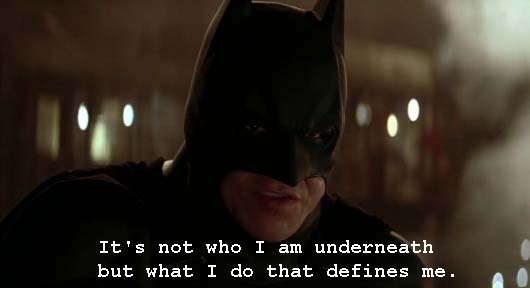
He came back with 11 steps to do so and 3 stages:
1. Creating your fictional character
2. Revealing him
3. Connecting with him
Step 9 is part of the second stage of the process, i.e. "Revealing your character".
In this article Cool Dude will cover the following:
Cool Dude:
Scott F. Fitzgerald wrote that Action is Character.
In terms of screenwriting this means that a fictional character is ultimately defined by what he does, not what he says.
The words reveal the point of view of the fictional character, the way he sees the world, based on the back story he has and how he experienced past events. These same words explain also why the character does what he does.
But it is his actions that reveal his true nature.
The actions of your fictional character speak volume about who he really is and have ultimately more weight than whatever he might have said before in your screenplay.
This is also what Alexander The Great says in the screenplay "Alexander", written by Oliver Stone and Christopher Kyle and Laeta Kalogridis.
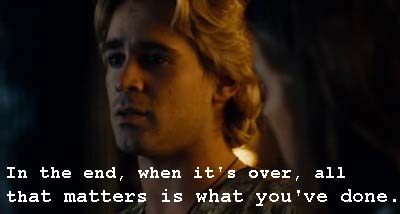
Action is a great way to reveal a character for 3 reasons:
There's a lot you can reveal about your fictional character through action. Think of:
One of the practice of many screenwriters is to take a piece of paper, make 2 columns, and write in the left column the traits of the fictional character and in the right column, how they will show these traits in the screenplay.
Let's illustrate this practice with 3 examples:
A) The Notebook written by Jeremy Leven
Left column - the trait:
The local country boy Noah Calhoun knows what he wants and will stop at nothing to get it.
Right column - the revelation:
A carnival scene where he meets heiress Allie Hamilton and asks her to go out with him.
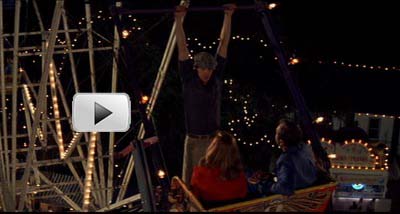
B) Bananas, written by Woody Allen and Mickey Rose
Left column - the trait:
The main fictional character, Fielding Mellish, is someone who means well but is clumsy.
Right column - the revelation:
A scene where he "guides" someone to park a car.
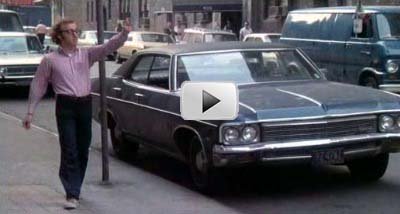
C) Basic Instinct, written by Joe Eszterhas
Left column - the trait:
Catherine Trammel is seductive, powerful and totally in charge.
Right column - the revelation:
the famous interrogation scene where she is alone in a room with 5 men grilling her with questions and she still has the upper hand.
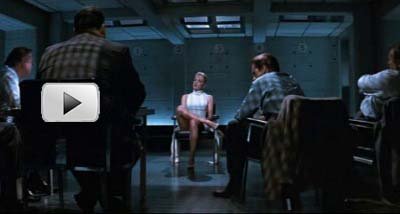
For the skills of your fictional character you can use the same 2 columns practice mentioned above and add a third column to show how the skills play out.
Let's illustrate this point:
A) The Amazing Spider-man , written by James Vanderbilt and Alvin Sargent and Steve Kloves
First column - the skill:
Peter Parker has the skills of a spider. He's incredibly flexible and strong, can spring meters high and stand upside down.
Second column - the revelation:
Peter is unaware that he got beaten by a spider. He takes the subway home and gets bothered. The new skills of Peter get revealed in a very powerful way by the screenwriters as the audience discover these skills at the same time Peter does. And both are very surprised. Check out the video.
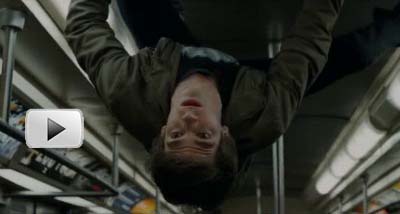
Third column - how it plays out:
Peter uses his new skills for the first time in the "Take it" scene, where the bully Flash Thompson wants to get his ball back. This is a powerful scene as it combines the demonstration of the skills with conflict. Besides it has the audience root for the main fictional character.

B) Good Will Hunting , written by Matt Damon Ben Affleck
First column - the skill:
Will Hunting is a genius who has many talents. One of them is speed reading and the faculty to memorize the information he reads.
Second column - the revelation:
This skill gets revealed in the opening scene, where Will reads a book and turns the pages very quickly.

Third column - how it plays out:
In the Harvard bar scene Will comes to the rescue of his friend Chuckie and gives a history lesson to a pretentious Harvard student.
This is a powerful scene as it shows the application of this skill in a conflict situation, in the presence of the future loving interest of Will. It reveals as well two important traits of Will: he cares for his friend and he's always ready to start a fight (with his mouth or with his fists).
The scene has besides an emotional impact. The audience identifies with the main fictional character and roots for him as we all have been in situations where we got embarrassed and wished to have known what to say in that moment.
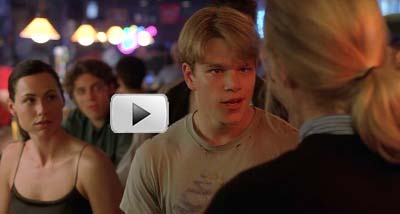
A very effective way to show a weakness or a hidden aspect of your fictional character is to have him say something and do something else. This technique can be used as well to show the starting point of the character's arc.
There is a great example of this contradiction in the screenplay "Batman Begins", written by Christopher Nolan and David S. Goyer.
Bruce Wayne has come back to Gotham to attend the hearing about the early release of the murderer of his parents. He talks to Rachel, about his motivation.
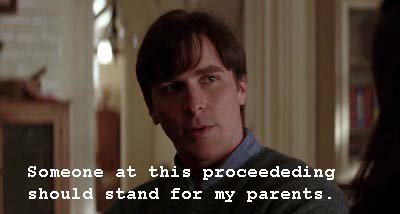
Then comes the proceeding. The murderer stands up and says that he regrets what he did. The judge then says:
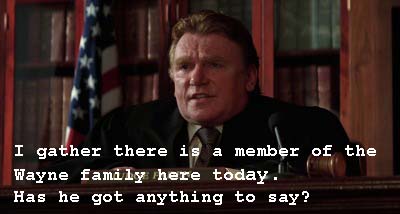
The action we expect from Bruce is that he will now stand up and speak. This would be consistent with what he said to Rachel.
What he does instead, reveals a facet of his character that we did not know so far. He stands up, says nothing and leaves the room.

As an audience we are left with this contradiction between words and action. We are left with Bruce weakness at this moment of the story.
One of the most efficient way to reveal who a fictional character really is, is to put him under a lot of pressure and force him to make a choice he does not want to make.
In Sophie's choice, screenwriter Alan J. Pakula shows how Sophie arrives at Auschwitz with her children and gets forced by a Nazi officer to choose which of her son Jan or daugther Eva, will accompany her to the camp while the other will be gassed.
She does not want to choose and even asks the officer to choose for her. But when the officer gives the order to take both kids, she sacrifies one.
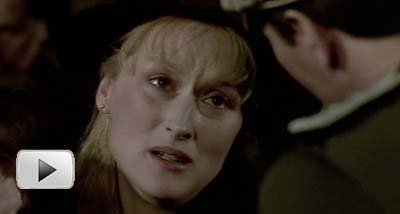
In the climax scene of Se7en, written by Andrew Kevin Walker, Detective Mills learns that the serial killer John Doe murdered his wife and put her head in a box.
Will he kill Doe and commit the seventh sin, vengeance, or will he let the justice take care of Doe? When he hears from Doe that his wife was pregnant, his choice gets even more difficult.


Pictures and screenplays:
-- "Batman Begins - Christian Bale (Bruce Wayne / Batman), Gerard Murphy (Judge Faden), Richard Brake (Joe Chill), Christopher Nolan (director), Wally Pfister (director of photography), Christopher Nolan and David S. Goyer (screenplay)
-- "Alexander" - Colin Farrell, Oliver Stone (director), Rodrigo Prieto (director of photography), Oliver Stone and Christopher Kyle and Laeta Kalogridis. -
-- "The Notebook - Ryan Gosling (Noah), Nick Cassavetes (director), Robert Fraisse (director of photography), Jeremy Leven (screenplay)
-- "Bananas" - Woody Allen (Fielding Mellish); Woody Allen (director), Andrew M. Costikyan (director of photography); Woody Allen and Mickey Rose (screenplay)
-- "Basic Instinct" - Sharon Stone (Catherine Trammel), Paul Verhoeven (director), Jan de Bont (director of photography), Joe Eszterhas (screenplay)
-- "The Amazing Spider-Man" - Andrew Garfield (Peter Parker), Marc Webb (director), John Schwartzman (director of photography), James Vanderbilt and Alvin Sargent and Steve Kloves (screenplay)
-- "Good Will Hunting - Matt Damon (Will); Gus van Sant (director), Jean Yves Escoffier (director of Photography); Matt Damon & Ben Affleck (screenplay)
-- "Sophie's Choice" - Meryl Streep (Sophie); Alan J. Pakula(director), Nestor Almendros(director of photography), Alan J. Pakula (screenplay)
-- "Se7en - Brad Pitt (Mills); David Fincher (director), Darius Khondji (director of Photography); Andrew Kevin Walker (screenplay)
Go from 11 Steps to Create a Compelling Fictional Character (step 9) to Whatascript! Home page
* The Departed, screenplay written by William Monahan